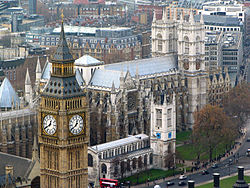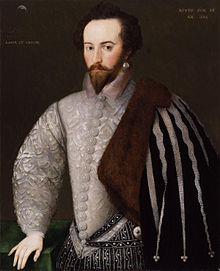Romance of London: Strange Stories, Scenes And Remarkable Person of the Great Town in 3 Volumes
John Timbs
John Timbs (1801-1875), who also wrote as Horace Welby, was an English author and aficionado of antiquities. Born in Clerkenwell, London, he was apprenticed at 16 to a druggist and printer, where he soon showed great literary promise. At 19, he began to write for Monthly Magazine, and a year later he was made secretary to the magazine’s proprietor and there began his career as a writer, editor, and antiquarian.
This particular book is available at googlebooks for free in ebook form. Or you can buy a print version.
The history of the painted glass cinquecento Window, which, in 1758, was placed in the chancel, over the altar of St. Margaret’s Church, is truly romantic.
This beautiful window (said to have been executed at Gouda, in Holland, and to have occupied five years in the making) was originally intended by the magistrates of Dort as a present to Henry VII., by whom it was intended for his Chapel at Westminster; or as some say, it was ordered by Ferdinand and Isabella on the occasion of Prince Arthur being affianced, in 1499, to the Princess Catherine of Arragon, their portraits being procured for the purpose.
The three middle compartments represent the Crucifixion, with the usual accompaniments of angels receiving in a chalice the blood which drops from the wounds of the Saviour. Over the good thief an angel is represented wafting his soul to Paradise; and over the wicked, the devil in the shape of a dragon carrying his soul to a place of punishment. In the six upper compartments are six angels holding the emblems of crucifixion: the cross, the sponge, the crown of thorns, the hammer, the rods and nails. In the right hand lower compartment is Arthur, Prince of Wales (eldest son of Henry VII); and in the companion or left side, Catherine of Arragon, his bride (afterwards married to his brother Henry VIII., and divorced by him). Over the head of Prince Arthur is a full-length figure of St. George, with the red and white roses of England; and over Catherine of Arragon, a full-length figure of St. Catherine, with the bursting pomegranate, the emblem of the kingdom of Granada.
Prince Arthur died before the window was finished; the King himself before it could be erected. Succeeding events—the marriage of Henry VIII. To the bride or widow of his brother, with the subsequent divorce of Catherine—rendered the window wholly unfit for the place for which it was intended.
The window through the ages
-
Henry VIII gave it to Waltham Abbey, Essex.
- At the Dissolution, Robert Fuller, the last Abbot, sent it to his private chapel at New Hall, also in Essex.
- It was later acquired by the father of Anne Boleyn.
- Queen Elizabeth I gave it to Thomas Ratcliff, Earl of Sussex, who was living at New Hall.
- It was purchased by Villiers, Duke of Buckingham, favorite of James I.
- Its next owner was Oliver Cromwell.
- At the Restoration, it reverted to the second Duke of Buckingham.
- It was purchased, along with New Hall, to General Monk, Duke of Albermarle. The duke buried it underground to keep it from the Puritans. After the Restoration he returned it to his chapel at New Hall.
- After he died and his son as well, the hall became the property of the duchess, and fell into ruin and decay.
- John Olmius, Esq., purchased the property and demolished the chapel, preserving the window.
- Eventually it was purchased by Mr. Conyers, of Copt Hall, Essex, for 50 guineas, for his own chapel.
- Conyers’ son, Mr. John Conyers sold the window in 1758 to the churchwardens of St. Margaret’s Westminster for 400 guineas.
“It is worth the walk”
It is worth a walk to St. Margaret’s to see this window. The late Mr. Winston, the great authority upon glass-painting, says of it: “Though at present much begrimed with London smoke and soot, it may be cited as an example of the pictorial excellence attainable in a glass-painting without any violation of the fundamental rules and conditions of the art. The harmonious arrangement of the coloring is worthy of attention. It is the most beautiful work in this respect that I am acquainted with.”
The church has been in our time, as it was centuries ago in Stow’s time, “in danger of pulling down;” which, if carried into effect, would add another leaf to the history of the St. Margaret’s Painted Window.
Thankfully, this last threat to the location of this window have not come to pass. I’m definitely putting St. Margaret’s on my list for this year’s trip, in August.
Romance of London Series
- Romance of London: The Lord Mayor’s Fool… and a Dessert
- Romance of London: Carlton House and the Regency
- Romance of London: The Championship at George IV’s Coronation
- Romance of London: Mrs. Cornelys at Carlisle House
- Romance of London: The Bottle Conjuror
- Romance of London: Bartholomew Fair
- Romance of London: The May Fair and the Strong Woman
- Romance of London: Nancy Dawson, the Hornpipe Dancer
- Romance of London: Milkmaids on May-Day
- Romance of London: Lord Stowell’s Love of Sight-seeing
- Romance of London: The Mermaid Hoax
- Romance of London: The Bluestocking and the Sweeps’ Holiday
- Romance of London: Comments on Hogarth’s “Industries and Idle Apprentices”
- Romance of London: The Lansdowne Family
- Romance of London: St. Margaret’s Painted Window at Westminster
- Romance of London: Montague House and the British Museum
- Romance of London: The Bursting of the South Sea Bubble
- Romance of London: The Thames Tunnel
- Romance of London: Sir William Petty and the Lansdowne Family
- Romance of London: Marlborough House and Sarah, Duchess of Marlborough
- Romance of London: The Duke of Newcastle’s Eccentricities
- Romance of London: Voltaire in London
- Romance of London: The Crossing Sweeper
- Romance of London: Nathan Mayer Rothschild’s Fear of Assassination
- Romance of London: Samuel Rogers, the Banker Poet
- Romance of London: The Eccentricities of Lord Byron
- Romance of London: A London Recluse









